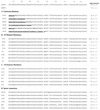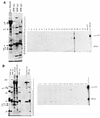Transcription of the Rhodobacter sphaeroides cycA P1 promoter by alternate RNA polymerase holoenzymes
- PMID: 9422585
- PMCID: PMC106841
- DOI: 10.1128/JB.180.1.1-9.1998
Transcription of the Rhodobacter sphaeroides cycA P1 promoter by alternate RNA polymerase holoenzymes
Abstract
These experiments sought to identify what form of RNA polymerase transcribes the P1 promoter for the Rhodobacter sphaeroides cytochrome c2 gene (cycA). In vitro, cycA P1 was recognized by an RNA polymerase holoenzyme fraction that transcribes several well-characterized Escherichia coli heat shock (sigma32) promoters. The in vivo effects of mutations flanking the transcription initiation site (+1) also suggested that cycA P1 was recognized by an RNA polymerase similar to E. coli Esigma32. Function of cycA P1 was not altered by mutations more than 35 bp upstream of position +1 or by alterations downstream of -7. A point mutation at position -34 that is towards the E. coli Esigma32 -35 consensus sequence (G34T) increased cycA P1 activity approximately 20-fold, while several mutations that reduced or abolished promoter function changed highly conserved bases in presumed -10 or -35 elements. In addition, cycA P1 function was retained in mutant promoters with a spacer region as short as 14 nucleotides. When either wild-type or G34T promoters were incubated with reconstituted RNA polymerase holoenzymes, cycA P1 transcription was observed only with samples containing either a 37-kDa subunit that is a member of the heat shock sigma factor family (Esigma37) or a 38-kDa subunit that also allows core RNA polymerase to recognize E. coli heat shock promoters (Esigma38). (R. K. Karls, J. Brooks, P. Rossmeissl, J. Luedke, and T. J. Donohue, J. Bacteriol. 180:10-19, 1998).
Figures





Similar articles
-
Metabolic roles of a Rhodobacter sphaeroides member of the sigma32 family.J Bacteriol. 1998 Jan;180(1):10-9. doi: 10.1128/JB.180.1.10-19.1998. J Bacteriol. 1998. PMID: 9422586 Free PMC article.
-
The Rhodobacter sphaeroides ECF sigma factor, sigma(E), and the target promoters cycA P3 and rpoE P1.J Mol Biol. 1999 Nov 26;294(2):307-20. doi: 10.1006/jmbi.1999.3263. J Mol Biol. 1999. PMID: 10610760
-
Transcription properties of RNA polymerase holoenzymes isolated from the purple nonsulfur bacterium Rhodobacter sphaeroides.J Bacteriol. 1993 Dec;175(23):7629-38. doi: 10.1128/jb.175.23.7629-7638.1993. J Bacteriol. 1993. PMID: 8244932 Free PMC article.
-
Activation of the cycA P2 promoter for the Rhodobacter sphaeroides cytochrome c2 gene by the photosynthesis response regulator.Mol Microbiol. 1999 Nov;34(4):822-35. doi: 10.1046/j.1365-2958.1999.01649.x. Mol Microbiol. 1999. PMID: 10564521
-
Evidence for two promoters for the cytochrome c2 gene (cycA) of Rhodobacter sphaeroides.J Bacteriol. 1991 Jul;173(13):3949-57. doi: 10.1128/jb.173.13.3949-3957.1991. J Bacteriol. 1991. PMID: 1648072 Free PMC article.
Cited by
-
Responses of the Rhodobacter sphaeroides transcriptome to blue light under semiaerobic conditions.J Bacteriol. 2004 Nov;186(22):7726-35. doi: 10.1128/JB.186.22.7726-7735.2004. J Bacteriol. 2004. PMID: 15516587 Free PMC article.
-
Metabolic roles of a Rhodobacter sphaeroides member of the sigma32 family.J Bacteriol. 1998 Jan;180(1):10-9. doi: 10.1128/JB.180.1.10-19.1998. J Bacteriol. 1998. PMID: 9422586 Free PMC article.
-
Promoter Architecture Differences among Alphaproteobacteria and Other Bacterial Taxa.mSystems. 2021 Aug 31;6(4):e0052621. doi: 10.1128/mSystems.00526-21. Epub 2021 Jul 13. mSystems. 2021. PMID: 34254822 Free PMC article.
-
Transcriptional activation of the Rhodobacter sphaeroides cytochrome c(2) gene P2 promoter by the response regulator PrrA.J Bacteriol. 2002 Jan;184(2):390-9. doi: 10.1128/JB.184.2.390-399.2002. J Bacteriol. 2002. PMID: 11751815 Free PMC article.
-
Activity of Rhodobacter sphaeroides RpoHII, a second member of the heat shock sigma factor family.J Bacteriol. 2006 Aug;188(16):5712-21. doi: 10.1128/JB.00405-06. J Bacteriol. 2006. PMID: 16885439 Free PMC article.
References
-
- Bagdasarian M, Lurz R, Rückert B, Franklin F C H, Bagdasarian M M, Frey J, Timmis K N. Specific-purpose plasmid cloning vectors. II. Broad host range, high copy number, RSF1010-derived vectors, and a host-vector system for gene cloning in Pseudomonas. Gene. 1981;16:237–247. - PubMed
-
- Bethesda Research Laboratories. BRL pUC host: Escherichia coli DH5α™ competent cells. Bethesda Res Lab Focus. 1986;8:9–10.
-
- Donohue T J, McEwan A G, Van Doren S, Crofts A R, Kaplan S. Phenotypic and genetic characterization of cytochrome c2 deficient mutants of Rhodobacter sphaeroides. Biochemistry. 1988;27:1918–1924. - PubMed
-
- Donohue T J, Kaplan S. Genetic techniques in the Rhodospirillaceae. Methods Enzymol. 1991;204:459–485. - PubMed
-
- Gross C A. Function and regulation of the heat shock proteins. In: Neidhardt F C, Curtiss III R, Ingraham J L, Lin E C C, Low K B, Magasanik B, Reznikoff W S, Riley M, Schaechter M, Umbarger H E, editors. Escherichia coli and Salmonella: cellular and molecular biology. Washington, D.C: American Society for Microbiology; 1996. pp. 1382–1399.
Publication types
MeSH terms
Substances
Grants and funding
LinkOut - more resources
Full Text Sources
Miscellaneous

